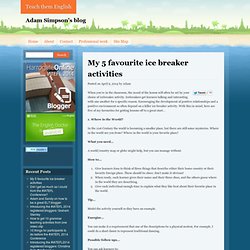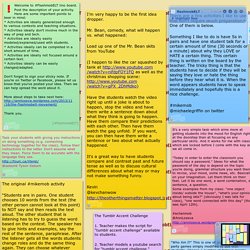

Thank you for joining Teaching Packs! - Teacher Well-being Bags. After an overwhelming response to the teacher well-being bags created this week on #PedagooFriday, I decided to blog about them here on Pedagoo.

Many people have asked me where I got the idea from, so I think that’s a good a place to start as any. The past few weeks have seen teachers blogging about their reflections on 2014 and hopes for 2015 using the #nurture1415 tag created by @ChocoTzar. Thanks to @sue_cowley who kindly collated them and you can find the full list of this year’s offerings here. These inspiring blogs are accompanied by @ICTEvangelist’s amazing posters. See here for those. In addition, a growing number of teachers have also been blogging about their #teacher5aday resolutions, an exciting initiative designed to promote well-being belonging to @MartynReah For an explanation by the man himself, see here.
(Original image taken by @MissEtchells) My role within the school is to improve teaching and learning. Initial feedback from the bags has been fantastic. Abbie. Agility-Teaching Toolkit. My 5 favourite ice breaker activities. When you’re in the classroom, the mood of the lesson will often be set by your choice of icebreaker activity.

Icebreakers get learners talking and interacting with one another for a specific reason. Encouraging the development of positive relationships and a positive environment so often depend on a killer ice-breaker activity. With this in mind, here are five of my favourites for getting lessons off to a great start… 1. Where in the World? In the 21st Century the world is becoming a smaller place, but there are still some mysteries.
What you need… A world/country map or globe might help, but you can manage without. Bobruv Pomocnik III. I need to teach vocab but I don't even know how to begin! This post's for you. I hope there’s a little bit for everyone in today’s post.

For teachers just starting out on their career, this whole post might serve as a useful guide in how to go about teaching vocabulary in the language classroom, while the experienced among us may wish to fast forward to the third section and explore the tools I suggest. Whoever you are, please drop me a line in the comments section and let me know if you found this post useful! Learning vocabulary is as important a step in developing future reading, listening, writing and speaking skills as any other aspect of language learning. Consequently, in this post I’ll reflect on what we teachers need to do in terms of dealing with what learners need to know about the words we want to teach, and how we can effectively teach them. In part one I’ll cater specifically to newbie teachers and briefly consider some of the most effective ways of presenting vocabulary. Ok, ready? Part 1: Effective ways of presenting vocabulary 1.4 Mime 2.2 The form.
FlashmobELT. Here is one of my favourite activities to practise writing stories (an important exam skill and just a fun thing to do!)

: Each student has a slip of paper and needs to write the first sentence of the sory. Two rules: it should something more exciting than "Once upon a time... " - something dramatic or unusual or funny, and it has to introduce the main hero (so "it was a lovely Saturday evening" won't go either). It could be something like, "When Linda saw a strange figure limping towards her in the dark alley, she realized she had left her chainsaw at home that day. " or "Humphrey Bumblebee never liked cucumbers, especially the red ones". Teens come up with most unexpected and brilliant stuff! Then they pass the paper to the next person, who reads the sentence and writes down one word they want to be used in the story. Then they pass it on to the next person, who adds one more word, etc.
In the end all the stories are displayed on the walls. Learning_through_outdoor_experience_a5. Bucket. Copyright © 2014 Emma Gore-Lloyd You don’t actually need a bucket for this activity.

You could use a basket, a box, an envelope, a mug, etc. It’s a game taken from It’s taken from one of my major sources of inspiration – improvencyclopedia – and is a great way to practice vocabulary with higher levels. Students win points for using new vocab (with my class, it was idioms and expressions) in role play situations. To play the game, you need a bucket (or basket, or envelope, or whatever you’ve got) of sentences. She’s in the public eye because…He doesn’t see eye to eye with …He looked me in the eye and said…“…” is her most influential work I gave them out to the students to complete, then we collected them in and put them in a bucket (it wasn’t a bucket, but that’s the name of the game). My class are proficiency level – what other levels do you think would find this activity useful?